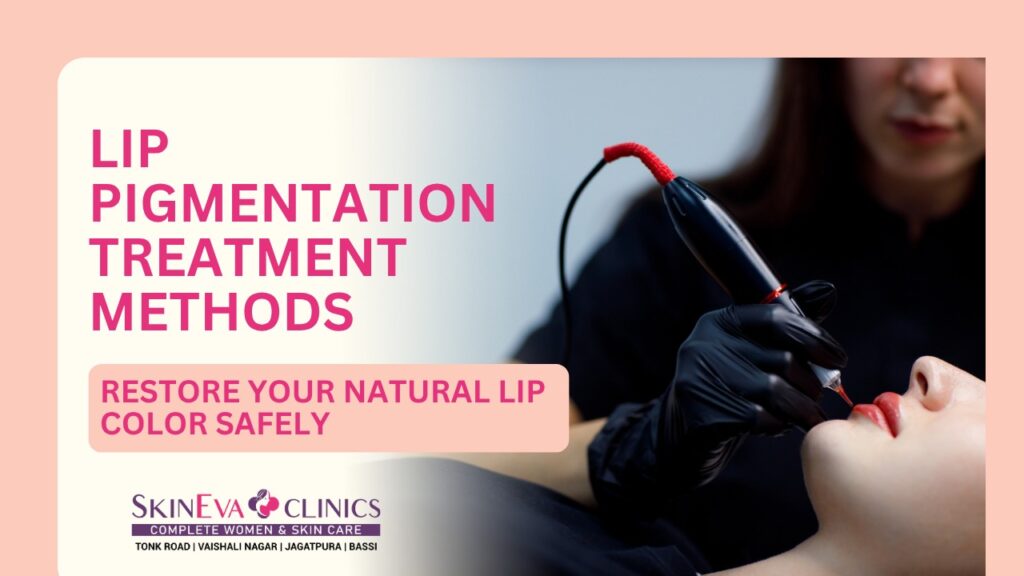Lip Pigmentation Treatment Methods: Restore Your Natural Lip Color Safely

Your lips, being one of the most expressive facial features, can reflect both your health and habits — yet they may darken or become uneven over time. This common concern, known as lip pigmentation or lip discoloration, can affect anyone and may result from various causes such as sun exposure, smoking, dehydration, or even hormonal changes.
In this detailed guide, we’ll explore everything you need to know about lip pigmentation — including its causes and the best available treatments like laser therapy, chemical peels, topical creams, and even cosmetic options like lip blushing. Whether your goal is to treat hyperpigmented lips, correct lip discoloration, or simply enhance your natural beauty, this article will help you understand the right path to achieving soft, pink, and evenly toned lips.
What is Lip Pigmentation?
Lip pigmentation is a common cosmetic concern in which the lips appear darker, patchy, or uneven in color compared to their natural tone. This condition, known as lip hyperpigmentation, results from excess melanin production in lip tissues.
The discoloration can affect the entire lip or specific areas, such as the upper lip, leading to an unbalanced or dull appearance. While it is usually harmless, lip pigmentation can impact one’s confidence and facial aesthetics since lips play a major role in overall facial harmony and expression.
Several factors contribute to hyperpigmentation in lips, including:
- Genetics: Some individuals naturally have darker lips.
- Sun Exposure: Extended UV exposure stimulates melanin, causing lip darkening.
- Smoking: Nicotine and tar from cigarettes darken the lips and increase pigmentation.
- Hormonal Changes: Pregnancy, birth control pills, or thyroid disorders may cause lip darkening.
- Dehydration and Poor Lip Care: Dry or chapped lips appear darker over time.
- Certain Medications or Allergies: Reactions to lip balms, toothpaste, or cosmetics can lead to pigmentation.
People with hyperpigmented lips or pigmented upper lips often feel self-conscious about their appearance, as lip discoloration can make the face look tired or uneven.
The good news is that several lip pigmentation treatments are now widely available. From laser lip lightening and chemical peels performed by dermatologists for pigmentation on lips, there are effective ways to restore natural lip color. With the right approach, it’s possible to achieve soft, evenly toned, and naturally pink lips — enhancing both confidence and overall beauty.
Effective Lip Pigmentation Treatment Options
There are several advanced and non-invasive methods to treat hyperpigmented lips. Depending on the severity of pigmentation and individual skin type, dermatologists may recommend one or a combination of the following treatments.
1. Laser Treatment for Lip Pigmentation
Laser lip lightening is among the most effective and advanced procedures to treat darkened lips. It works by targeting excess melanin (the pigment responsible for dark coloration) with specific laser wavelengths.
- Technology Used: Q-Switched Nd:YAG Laser
- Procedure: The laser energy breaks melanin into smaller fragments, which are gradually absorbed and cleared by the body.
- Sessions Required: Most treatments need 3–6 sessions spaced about 3–4 weeks apart.
- Benefits:
- Non-invasive and safe
- Minimal discomfort
- Suitable for Indian skin tones
- Long-lasting results
Laser treatment is ideal for deep or stubborn pigmentation that doesn’t improve with topical creams or chemical peels.
2. Chemical Peels for Lip Pigmentation
Chemical peels are another popular lip pigmentation treatment method used to gently exfoliate pigmented lip skin.
They work by removing the outermost dead skin layers and stimulating the regeneration of new, lighter cells.
- Peel Types: Glycolic acid, lactic acid, mandelic acid, or kojic acid
- Procedure: A mild solution is applied to the lips for a few minutes and then neutralized.
- Sessions Required: 3–5 sessions depending on severity
- Results: Gradual lightening and smoother texture
Chemical peels are ideal for mild to moderate lip discoloration and can be combined with topical treatments for enhanced results.
3. Topical Creams and Serums
For mild pigmentation, dermatologists often recommend topical creams that help lighten lips gradually. These formulations inhibit melanin production and promote a more even tone.
Common active ingredients include:
- Hydroquinone: Reduces melanin formation (use under medical supervision)
- Kojic Acid: Naturally derived brightener that helps fade pigmentation
- Arbutin: Gentle alternative to hydroquinone
- Vitamin C: Antioxidant that boosts collagen and brightens the skin
- Azelaic Acid: Reduces pigmentation and inflammation
- Retinoids: They boost skin cell renewal and help lighten dark spots effectively.
Application: Twice daily for 4–6 weeks (or as directed by a dermatologist)
Topical products are safe to use for maintenance after professional treatments such as lasers or peels.
4. Lip Blush (Semi-Permanent Makeup)
Lip blushing is a cosmetic correction technique designed to improve lip coloration.
It involves depositing safe pigments into the lips using a micro-needling device to create a more uniform, natural tint.
- Duration: Around 2 hours
- Results Last: 1–2 years
- Ideal For: People with naturally dark lips or uneven lip tone
While not a medical lip pigmentation treatment, lip blush offers an aesthetic solution for those seeking instant, long-term enhancement.
5. Microneedling with Brightening Serums
Microneedling creates controlled micro-injuries on the lip surface, boosting collagen production and allowing better serum penetration.
When paired with vitamin C or tranexamic acid serums, it helps reduce hyperpigmentation in lips and improves lip texture.
- Sessions Required: 3–6 sessions
- Benefits: Natural collagen stimulation, improved hydration, smoother lips
6. Lip Fillers for Pigmentation Correction
While lip fillers are primarily used for enhancing lip volume, hyaluronic acid fillers can also help reduce the appearance of pigmentation caused by aging or thinning. They restore smoothness, hydration, and even tone.
At-Home & Preventive Care Tips
While professional treatments deliver faster results, good lip care habits are essential to maintain long-term improvement and prevent recurrence of lip discoloration.
- Use SPF Lip Balm: Always apply a broad-spectrum SPF 30+ lip balm daily to protect against UV damage.
- Stay Hydrated: Dehydration accentuates dullness and dryness.
- Avoid Smoking: Tobacco is one of the leading causes of dark lips.
- Limit Caffeine: Too much coffee or tea can darken lip color.
- Gentle Exfoliation: Use a gentle sugar scrub once weekly to remove dry or dead skin cells.
- Avoid Low-Quality Lip Products: Opt for dermatologically tested lipsticks and balms.
Why Choose Professional Lip Pigmentation Treatment
Professional lip hyperpigmentation treatment ensures:
- Customized care: Treatment plans are customized according to your skin type and level of pigmentation.
- Faster results: Compared to home remedies
- Safety: Procedures are conducted under expert supervision
- Long-term maintenance: Dermatologists provide aftercare and prevention plans
Expected Results & Aftercare
After a few sessions of lip pigmentation laser treatment or chemical peels, most patients notice:
- Lighter and pinker lips
- Improved texture and hydration
- Even lip tone
Aftercare Tips:
- Keep lips moisturized at all times
- Avoid spicy or acidic foods for a few days post-treatment
- Do not pick or peel dry skin
- Apply SPF daily
Conclusion: Achieve Naturally Pink, Healthy Lips
Lip pigmentation treatment is a safe and proven way to restore your lips’ natural color and beauty. From laser toning and chemical peels to topical creams and cosmetic lip blushing, there are multiple solutions available for hyperpigmented lips.
If you’re struggling with lip discoloration, consult a qualified dermatologist. With proper diagnosis and a personalized plan, achieving soft, even-toned, radiant lips is possible.



Leave a Comment